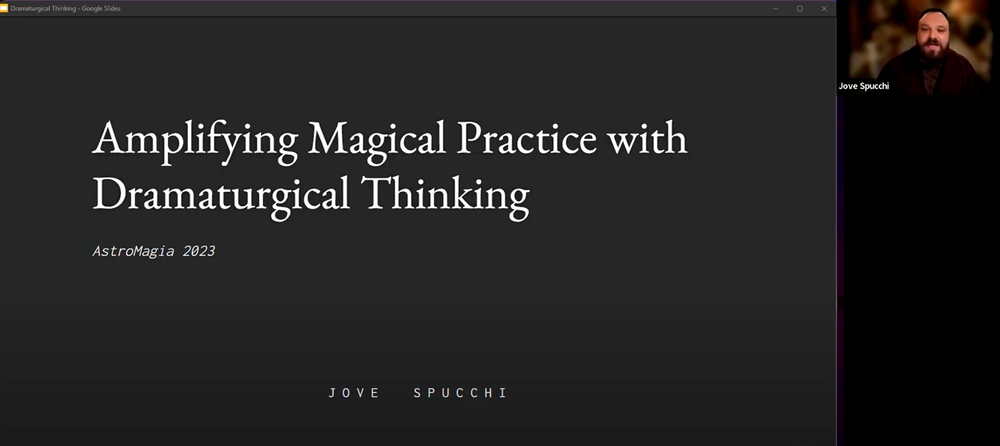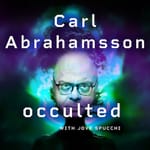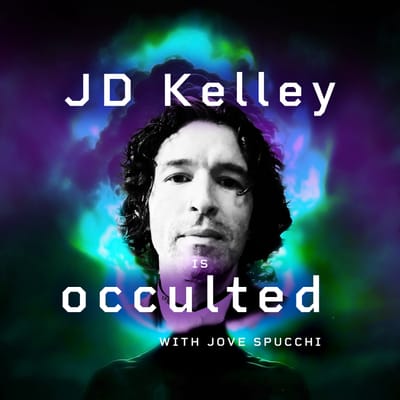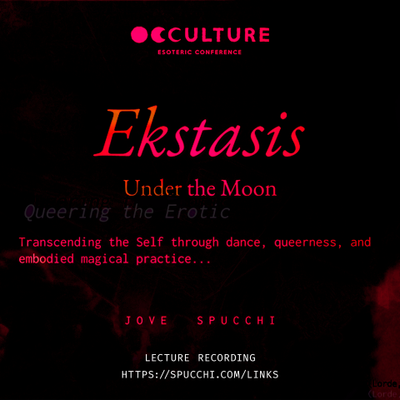Hello, I've finally gotten around to uploading the recording from my AstroMagia 2023 talk Amplifying Magical Practice with Dramaturgical thinking from November 2023.
The talk gives an introduction to dramaturgy and performance theory with particular focus on Victor Turner's work on rites of passage and the ludic margin. Drawing from my own practice in astromagic, I give examples of how different sensory elements can be used to propitiate energies and entities and level-up your ritual.
Abstract: Individually and collectively, we are joined in an eternal dance with the celestial spheres– each interaction with the magical other is a movement within the larger choreography of our own spiritual development and our changing roles within spiritual ecologies. Approaching magical practice from the perspective of the dramaturg offers the critical theory and expanded praxis of performance as tools to enrich and enhance both ritual and relationship.
Together we'll explore the dramatic structures of dance, theater, music, and visual art as ways to inhabit planetary archetypes and narratives with the body, and have them inhabit us in-turn. Drawing from my own experiences with butoh, ecstatic dance (raves), astro-drama, and multimedia talisman creation, we’ll discuss accessible and practical strategies for maximizing the presence, beauty, and intentionality of each facet of our experience as practitioners.
Thank you for being a member! Enjoy the video lecture, and the lecture notes that I was working from during this presentation.
Many thanks to JD at AstroMagia for booking me for this talk.
My notes for the lecture are below.
Title Slide
Hello I'm Jove-- it's so good to be here with you all. The opportunity to share some of what I've been working on with an audience of fellow practitioners so rooted in astrology is truly a special one. I feel a great deal of gratitude to JD, Q, and team for so thoughtfully creating this space for us, and to all of you who are here in attendance.
Today I'd like to share my own, emerging explorations of an expanded definition of dramaturgy-- a framework typically used for critiquing, developing, and deepening performances in theatre and contemporary dance. I've found this method of "dramaturgical thinking", a sort of, "art direction of eros", to be incredibly potent for enriching my astromagical practice and deepening my relationships working with spiritual others.
These thoughts and methodologies are informed by my own practice and path, carrying with them the unique peculiarities of relationships and desires, successes and failures-- the things that make magical work so inextricably personal. How you decide to explore and apply these concepts can, and should, look different depending on the resonances you feel in your own practice, lineage, and tradition.
This approach is one of courting and enriching sensual and erotic engagement-- both for the multiplicitous self and rotating cast of co-conspiring others. This raising of Eros is, to me, the offering with which to feed the Daimon-- the charge that completes the magical circuit, the heat that sets all things in motion, an ever-moving entropic dance.
An Intro: How I Arrived at Performance
Dance and Performance has only more recently become the umbrella framework through which I view and understand my practice. With many years spent orchestrating technology infrastructure and teams for my day job, and organizing nightlife and group ritual practice in my time off, the disparate fields always felt too dissonant to come together under the same corpus of work.
It wasn't until I started studying and practicing butoh-- an avant-garde dance form borne out of post-war Japan, that I started to feel the pull of a common thread throughout my work: the choreographic. In my flavor of practice, the butoh dancer seeks to relate to all things on the level of equal, letting the spirit of the thing move and animate the body, rather than the intentional movement directions of the mind-- a type of animism where all things have and share their own dance, their own choreography.
It is through the lens of "choreographic research" that I've begun to frame my practice-- the compulsions of the body to seek knowledge and conversation with the other, to explore the vastness of experience through the sensual and the erotic, the curious drive of the embodied self that exists outside and between the structures of language.
This curiosity has been the guiding light for my ritual work, a strong desire to build relationships of understanding with the spirits of things, engaging with the world from an increasingly-animistic perspective. As my understanding continues to evolve, the call to relate with the world of spirit and form in new ways becomes ever louder, more urgent. Our classical notions of ownership and hierarchy no longer fit within our metaphysical understanding-- we know too much to ignore the violence that is wreaked when we take upon us the role of the master.
To move in reverence of the other, no matter how other, is to respect the sophistication of the ecologies we exist and participate within. The dance we see unfolding before us is an eternal choreography, a movement of bodies celestial, ethereal, and earthen-- that which we are only just joining, our chance to observe and then mime and then-- if we're particularly cunning of mind and quick on our feet-- begin to improvise within.
It is from this perspective that I approach my ritual work-- an inherently research-based practice that seeks to co-create, rather than enforce, relationships with spirit.
Practical Context: Solo Workings
My ritual practice is rooted in electional astrology, understanding the chart cast as a sort of prism for the energies of entities, egregores, archetypes, and desires-- each moment with its own propensities and potentialities for different kinds of workings. Sometimes this is a window I elect and plan for intentionally, and other times it is a charged moment that emerges unexpectedly-- a case when I'll cast a chart in the aftermath to better understand and contextualize the experience in retrospect.
I work extensively with planetary days and hours as windows of time when the energies of the planet, or the planets in-question, broadcast most clearly. In these moments, if we are in right-relationship and good favor with the planets we're working with, we may access forces that are ripe for directing into desires and actions-- as long as they share the flavor of the archetypes, relationships, and dignities on offer from the skies.
It is within these windows, and under skies of particularly potent astro-weather, that I most often stage a working-- both in my solo-practice and group ritual operations. For me, these rituals are a performance-- sometimes in honor of, and other times in concert with, the astrological entities present in the moment. These performances take on varied forms and levels of complexity depending on the rarity of the astrological configuration and the strength of the desire and intent I'm bringing to the altar.
In daily practice, this is often the lighting of an incense resonant with the planetary archetype, a meditation on its principles and how they are woven into my life, a reading of an ode or hymn, an expression of gratitude, a casual conversation with the planet's imagined, personified form. Wearing colors and materials pleasing to the aesthetic sensibilities of the planet, I tune my affect in alignment to the character I'm continually sculpting from the planet's mythic depictions and my own encounters with them in ritual, nature, and other people's charts.
This tuning takes into account the current placement and conditions of the planet, anticipating a certain type of mood and imagining the types of social dramas that they may be engaged in as represented by their aspects and dispositorships with other planets and bodies. Here, knowledge of myths and their polyvalence, gives a sort of framework to project how the personified form of a planet might behave within their current conditions, empowering the magician to better channel and understand their energy before meeting them in mimesis.
Practical Context: Group Workings
This participation in narrative mythic archetypes extends to my group practice as well, often with fellow participants spontaneously taking on the roles of the heavenly bodies that are currently at-play, whether it is within their own charts or in a more mundane sense. The mode of group practice I most often work within is that of the nightlife, the party, ekstasis through celebration-- here, dance is central to our embodiment and propitiation of the spiritual other.
Working together over the course of a decade, our little coven has developed its own language of rites and symbols that depict the katabasis narrative. We descend into the underworld with an intent to learn, meet, or retrieve something through the experience of ordeal-- an altered state brought about through the taking of psychoactive sacraments and reveling together in wild fits of dancing. It is in the swirl of the dance floor that we meet with the spiritual other to find what it is we seek in ekstasis.
As we have experimented with this building of erotic energy, we have found that the more we lean in to intentional mimesis and performance of mythic narratives and archetypes, the better we are able to use their features to direct energy in toward what we desire. Often in our own natal charts, our characters have already been cast, our movements already scored. When we radically engage with the principle "as above, so below" through ecstatic channeling and mimesis, we are able to access the legacies of knowledge and power held within these ancient stories.
It is through this practical exploration and support of my fellow witch dancers that I have come to use the language and tooling of choreography to describe my magical practice-- here, we were led by the frequent emergence of "khoros", the round dance, dancing in unison-- something that seems to arise organically when we are all fully, ecstatically, erotically engaged on the dance floor.
This full engagement of the body, mind, and spirit is what I seek to replicate across all of my ritual workings-- a completed erotic circuit primed for channeling and directing energy, a perfect and most beautiful vessel sculpted to hold the object of our heart's desire. In these moments of attunement, it feels like we have given a satisfyingly convincing performance to our astral audience, our characters believable, our costumes and decor evocative enough to warrant applause, grant a desire-- and if we were particularly spectacular, we may even receive the blessing of a boon. It is here where the realms of performance and ritual, the methods of amplifying their effects and enhancing their reception, seem to blend.
Part I: A Brief History & Theory of Dramaturgy Title Slide
Before jumping in to practical application, we'll explore the history and theory that led to the emergence of dramaturgy as we know it today. This history focuses on the lineage of Greek, or as it's often called "Western" theatre. Similar concepts, histories, and cultural technologies exist alongside this one throughout many parts of the world, but are largely outside the scope of this talk.
Ritual and Performance: Shared Utility as Social Redress
The similarity between the effects, or applications of performance and ritual, is discussed extensively by anthropologist and ethnologist Victor Turner, who situates both within his "Ritual Processes" category of social redress.
Turner describes the archetypal social drama in four stages-- a process through which societies often deal with transgressions of social rules and expectations:
- Breach - An individual or non-majority group breaks the rules, breaching the social contract of the community
- Crisis - conflict arises between emerging factions, illuminating the differences between them and revealing what seem to be irreconcilable differences. This continues to escalate, and begins to threaten the cohesion and viability of the community
- Redress - the governing mechanism, or leaders of the community take action to reconcile these differences, often in a way that is ritualized
- Reintegration/Schism - depending on the outcomes of the redressive process, those in breach of the social contract are either reintegrated into the community or split off, their differences truly irreconcilable for the rest of the group.
Turner relates performance and ritual by grouping them together as "Ritual Processes", those which differ in utility and form from both political and legal-judicial modes. Ritual Processes serve to ameliorate the private, personal, and social maladies of the community, rather than the more public and political ones. Both the treatment of the sick through curative ritual and the narrative depiction of rites-of-passage in the theatre, contribute to a community's externalized-then-internalized "social metacommentary"-- creating a sort of collective unconscious where real and imagined symbols can relate to their meanings in the potent poetry of abstraction, metaphor, and inversion.
Performance and Ritual: Shared Mode of Liminality
It is this poetic, potentiated slurry of symbols and disassociated meanings that Turner references when further complicating the relationship between performance and ritual, linking them through their shared mode of liminal journey and potential for containing more and different types of information than the relatively concrete modes of politics and the law. He argues that the more legalistic forms of redress do not have the room for abstraction to support the more nuanced aspects of the internal self and private social worlds. The use of the liminal within performance and ritual provides a permissible mechanism for crossing the thresholds and boundaries of social culture and taboo-- a neutral non-space where the dissonances of crisis can be flattened, safely handled, and collectively metabolized toward resolution.
Here we see the ritual process broken up into three phases:
- Separation - which I see as the necessary othering of the practitioner or performer from both the mundane and the baseline self
- Marginality - The potentiated in-between space where we perform ritual, free to understand and reify ideas and energies outside the boundaries of language, logic, and form.
- Reaggregation - The return to form, hopefully integrating whatever was shared in the liminal phase by performers, participants, and spiritual others
This progression feels particularly potent to me as a framework for crafting both performance and ritual. In broad, generative strokes, it describes the archetypal, ecstatic process at the core of many magical systems and narrative frameworks: solve et coagula, the shamanic journey, the baptism, refiner's fire, the witch's ordeal, initiation, katabasis.
In each of these examples, the fertile garden of liminality only offers its fruits to those who are willing to walk in the dark. We must journey far beyond the reaches of the solar rays of sense and reason to fully know and feel the depths of meaning offered in total mimesis. In this dissolved state we must rely on our other felt senses, our desires, our mirrors found within the other-- to catch fresh and truer glimpses of ourselves, no matter how monstrous they may be. Here we must also confront and embody the shadow, the other, the dark, the malefic-- otherwise we risk laying claim to characters and powers that are not our own with only half a mask to wear, the grand illusion losing its luster for our celestial audience we so implore.
Performance and Ritual: Shared Complication of Audience
When we are successfully working in liminality or ekstasis, the boundaries of performer and audience; channeler and spirit, begin to dissolve. This complication of audience can be seen in the genius of the Chorus in ancient Greek theatre. Speaking and dancing in unison, this group of twelve to fifty performers represented the collective voice and opinions of the people throughout the major narrative movements of the play. The Chorus provides an even deeper level of social metacommentary to the audience by giving them an explicit double, complete with opinions and responses to the narrative being explored.
Poet and critic, August Schlegel, describes the Chorus as the ideal spectator-- an exemplary audience that is deeply implicated in the contextualization of characters and plot. In acting out the assumed role of the audience, the Chorus further muddies the distinction between performer and audience; the real and imaginary. Through the Chorus, the audience is inserted into the world of the play. Being played by actors, the audience's typical roles of commentator and judge of character are seemingly filled-- the feelings that the audience are supposed to feel have already been expressed, the digestion of the narrative has already been done. This use of sympathetic magic not only casts the spectator within the story, but gives them characters through which they are intended to interpret the meaning of the play.
These sympathies between audience and performer are seen within the world of dance as well. There are ongoing studies examining how contemporary dance produces audience entrainment-- a process by which the bodily rhythms of performers and audience synchronize during a performance. In 2015, the Frontiers in Human Neuroscience journal published research showing that the breathing rates and rhythms between dancers and spectators synchronized over the duration of the performance-- the body of the spectator co-performing the breathed component of the choreography. They found that when audience members paid closer attention to the dancer's movements and muscular activity, the more in-sync their breathing would be. The study also correlates these moments with altered states-of-consciousness that changed the way audience members experienced time.
In both of these examples, we see how performance creates a liminal field that encompasses both performer and spectator, clouding the distinction between the two. I liken this to the ecstatic experience in ritual where, in meeting with spirit, the boundaries between self and other are obscured. The practitioner, the vessel, works the operation as performer, playing their part for spiritual spectators until that threshold into the liminal is crossed. Now as audience to the other, they continue to perform for whom they host until the show is done.
Performance and The Body
The interrelatedness of performance and ritual can be seen throughout history, with examples ranging from the shamanic rites of Paleolithic cave dwellers, to the Christian televangelists of modern America. Whether it is for the purpose of moving an audience of flesh or spirit, when we perform actions with a focused intent and desire, they hold an undeniable power to initiate a reaction or change in the onlooker.
What differentiates a performance as powerful, is both the number and intensity of resonances it activates within the audience. When enough of the symbolic connection points find affinity between performer and observer during the liminal moment of a performance or ritual, a gestalt emerges, transmitting more information to the viewer than the symbols originally held.
Human bodies, oft described as containing a spark of the divine, are able to encode and transmit a staggering amount of information to one another, even without the use of spoken language. The slightest movement of the face can convey a torrent of emotions, a simple adjustment of posture can cause the room to interpret you as an entirely different character. The ways that even a naked body moves and holds tension, reacting to the shape and form of all it touches, is enough to tell a full story in and of itself. Even alone, the body may perform mimesis, the power to create forms.
When we add to this storied body the forms of tools, clothes, and ritual objects, an entirely new dimension of action is unlocked: the technology of the image and the symbol-- the ability to inspire anything we touch with the power of the imaginal.
And from these symbols comes the power of language-- the ability to encode our full experience within ideas represented in as many ways as we can dream up. It is from language, in all of its forms, that we have the power to perform magic-- the privilege of elevated agency within these earthen bodies to express and to feel and to love and to hurt.
Exploring the full potential of this agency, this ability to work magic through the many languages of the sensual and the erotic is, to me, the dramaturgical approach of the magician. Animated by curiosity, desire, and the appetites of Eros, we have the ability to direct these forces into meaning-making that can stir even the most distant of spirits into action.
This method of meaning-making, instilling an act with the most powerful and poignant of symbols, is where I find myself looking to dramaturgy for technologies that might enhance or amplify ritual potency.
What is Dramaturgy?
"Dramaturgy" was first used to describe the art of "play-making", and still carries the meaning of playwright in many languages. In its current, most common usage, it's applied across performance mediums to describe the art of making a good performance the very best it can be.
The term originated in the world of theatre, where it still carries the meaning of what writer and dramaturg Magda Romanska calls "a comprehensive theory of dramatic structure" which includes composition, architecture, script writing, analysis, research, production, critique, and engagement with whatever contexts the play might interact with. The term found its use in Gotthold Ephraim Lessing's 1769 collection of essays on the dramaturges of Hamburg, describing the role as a sort of in-house critic who helped the theatre to improve and refine a play during its development process. Lessing himself took on this role, establishing the profession of dramaturg for posterity, albeit with his own intent to challenge public tastes with the highest of standards in aesthetic sensibilities.
It wasn't until theatre practitioner Bertolt Brecht expanded the role of the dramaturg in the early 1900s, that it came to include such a broad range of activities such as conducting research to ensure historical accuracy, modulating the political tone to convey the intended message, and perfecting the aesthetic form of the play from rehearsal to production. Working most closely with the director, Brecht acted as liaison between the team and the audience, writing program notes and publishing theoretical articles on the production to give further context to both critics and the public.
The field of dramaturgy continued to develop and grow throughout Europe, eventually gaining traction in the American theatre scene, and in 1977 dramaturgy is introduced as an MFA program at the Yale School of Drama. Gaining wider visibility in theatre magazines, it soon became a fully-fledged discipline and profession. The wide range of general performance and theatre knowledge required for the role allowed particularly enterprising experts in the field to bring this mode of working into other art forms like dance, opera, film, television, and even literature.
An Expanded Definition of Dramaturgy
As the field of dance metabolized dramaturgy, innovators like Pina Bausch reworked their creative processes, moving away from the strictures of traditional hierarchies of choreographer and dancer that imposed a top-down style of communicating choreography. Instead, Bausch took a more generative approach, posing questions to the dancers to inspire their movement, leaving room for interpretation and encouraging an embodied understanding of the concepts they were to perform.
This way of developing a work, framed through the posing of a question, is the dramaturgy I propose for those of us looking to deepen our ritual practices. The role of the dramaturg is inherently aspirational, a way of seeing that creates space for the ideals of the imaginal to bloom and grow in the experience of the real.
As we integrate the concepts of dramaturgy into our magical work, Bojana Bauer's notion of "becoming through practice" describes a dramaturgical approach ritual practitioners are likely already familiar with. It is through the work that we learn about ourselves as astrologers and magicians, and it is through the process of interrogating that practice that we are able to refine it.
This expanded definition of dramaturgy not only applies to rituals that contain elements of performance and theatre, but also to workings that involve the creation of physical objects such as astrological talismans, or magical materia.
Dramaturgical Thinking for Practitioners
To apply these principles to our own practice, we must enter the mode of dramaturgical thinking-- in this question-driven approach, we can use the following principles as dimensions in which we can understand and develop our ritual:
- Intent
- What is the goal of the ritual? Is it to learn? To change something internally? Externally? Is it to simply communicate? Express gratitude? Or is it simply curiosity? A desire for knowledge and conversation with a planetary energy?
- Audience
- What "things" are within the sphere of influence of your ritual? Earthen and celestial, magical and mundane, living things and objects. How might they interact with your intent? How might they interact with other members of audience? How are you, as practitioner, also an audience member? What about fellow practitioners? What does this mean in terms of ritual preparation?
- Action
- What actions are you and fellow practitioners taking to demonstrate your intent? How are they interacting with all levels of Audience? What are the side effects of these actions? How might they be interpreted by different types of consciousness? How does inaction, or the thing you are not doing, impact the ritual?
- Style
- What patterns do you see in the way that you are doing things? In the objects involved in your ritual? In the ways that you interact with audience? What symbolic languages are you accessing, creating, remixing, ignoring throughout your work? How do these patterns enhance, diminish, or otherwise interact with your intent? What embellishments can you add or how can you edit down your actions and their accoutrements in a way that aligns with the erotic sensibilities of the parties involved?
- Context
- In what place, in what time are you working your ritual? Is this an event in a series. or a one-off? What moment did you just come out of? What moment will you enter after the fact? What is the lineage or tradition you are working within? What is the current astro weather and how does it color your experience? What meanings do your intents, actions, and styles take on as they exist in these contexts? What can you do to decontextualize aspects of your ritual?
- Embodiment
- What is the state of the body upon entering ritual? What energies does it carry from its intent, actions, and context? How does the natal chart impact the ritual, the other practitioners, the audience? How does being embodied as a human change your context? How does the body meet the other, how is it shared? How do aspects of the ritual feel in the body, what is it telling you?
This is but a small sample of principles and generative questions that the practitioner can ask themselves when developing their working. With all of the many paths that diverge in this mode of thinking, the iterative, practice-based nature of dramaturgy becomes apparent.
It is through trial and error, and most importantly, cultivation of an embodied sensitivity to the energies and entities we work with, that we can rework and refine our practice. Though many of us tend to work in and prefer a solitary practice, I speak from experience when I tell you that there is no faster way to learn and improve than being in dialog, and in ritual, with other practitioners.
It is through group workings, and distribution of the responsibility of the dramaturg to ALL members of cast and audience, that the deepest of resonances and most reality-changing outcomes will emerge. Just as the wandering stars themselves, we are in relation to all those around us through seen and unseen symbols and their meanings, regardless of whether or not we choose to to engage them with intention.
Those relationships are paths over which energy flows, and developing an awareness of these connections and their charge will empower you mediate them.
Applying Dramaturgical Thinking to Ritual Practice
As we explore these relationships, there are certain ideas, entities, and egregores that have particularly strong resonances with the planets and bodies we are working with. Esoteric knowledge systems seek to communicate the fertile abstractions and gestalt of the liminal experiences we move through in confrontation with the spiritual other. As such, they often have highly developed symbolic languages, mythos, and practices that access and transmit embodied and chthonic knowledge.
In my Astromagical work, these bodies of knowledge form a sort of biography for the planet I'm working with, giving me a baseline from which to build a relationship and framework to contextualize the outputs of ongoing practice. While there are surely others, the ones I turn to most frequently are as follows:
- Correspondences
- Though there are many different versions of these systems, they are an incredibly useful tool for characterizing a planet and its relationships across symbolic languages and practice modes. These range from the astrological criteria we use to understand essential dignity, to links with other occult systems and knowledge traditions such as tarot, geomancy, and herbalism. These correspondences not only characterize ritual audience, but also serve as a wealth of inspiration for enriching and attuning your work to the erotic sensibilities of the planet-in-question. I most often use these when thinking about leveraging and creating context, and appealing to senses of style.
- Mythic Narrative Archetypes and Characterizations
- Maybe the most potent on the list, the myths and stories of the planets we work with are endlessly rich in their potential for mimetic work. Woven throughout our culture and collective unconscious, our myths represent human knowledge that spans from the earliest creation of the symbol to the newest, emergent forms of meaning-making. Containing both the magic of remembering and forgetting, they depict archetypal relationships in both the celestial and mundane that can be reified as magical tools for moving and directing energy. Through mimesis, we can wear the mask of a planet and tap into its archetypal relationships and affinities, as well as its shadows and poisons. Understanding the corpus of mythos that involves the planet-in-question provides material for Context, Audience, Action, Style, and Embodiment-- all things that we can employ to successfully develop relationships with the planets we work with.
- Experience of Planetary Archetypes in Other People
- Our lived-experience of planetary archetypes is often the most resonant for us and contextualizes the understanding gained from mythos in our present time and place. As astrologers, we see these mythic narratives played out and embodied by those we read for. I find that my experience with client charts best characterizes the personal planets, depicting how their attributes and affinities can be embodied and expressed in the world. This is incredibly useful when exploring the Actions you might take in your ritual, especially when working with energies that might not be present in your own chart.
- Experience of Planetary Archetypes in The Mundane
- For the outer planets in particular, the mundane expressions of planetary archetypes proffer near endless material for understanding Context and Style within a work. When we look at generational trends and longer planetary cycles, a broader context of extended temporality emerges, situating our work with an awareness of the audience that watches patiently from afar.
- Embodied Knowledge
- As we develop our praxis, it is not only the Solar and intellectual understanding that accumulates, but also the more Lunar and embodied understanding of what relationships with planetary bodies FEEL like. This intuition, or felt-sense comes from embodiment and accesses the chthonic knowledge and contexts of the planets and the cycles they exist in. I feel that many of us within astrology and magic are so steeped in the logos of our work, that we may forget that everything we do is mediated by and expressed through the body. When attuning your ritual with dramaturgical thinking, the body is the best instrument you have to receive feedback from your spiritual audience.
Again, these are just examples of ways that you can tune your ritual practice and the role of the dramaturg is to develop new modes of working and bodies of references through practice-based research. This, fundamentally, is a practice of courting and seducing Eros-- inventing new ways to weave him in to our actions and our forms. Each question we ask should seek to appeal to the senses of the body and sensibilities of the mind and spirit-- for this is how we know, and this is how we relate with the other.
Alternative Dramaturgical Strategies
While nearly all of the strategies discussed thus far focus on resonance with classical modes and forms, there are other, more advanced approaches that can be incredibly powerful. These modes of working disrupt the linear cohesion of the dramatic form and the appeal to pleasurable erotic sensibilities to create an altered state or perspective in both the performer and the audience. While I don't suggest working this way without significant first-hand experience and exceptionally robust support systems, I've found that sometimes it is best to interface with the more chaotic and malefic energies using the shared language of dissonance, crisis, and disruption.
Antonin Artaud's Theatre of Cruelty and resulting works by creatives like Jean Genet and Peter Brook, are choice inspirations for this type of work-- assaulting the senses of the audience with the ludity, baseness, and chaotic beauty of the unconscious and the shadow, they disrupt perception and logical modes of thinking to invoke the animal, chthonic, and the feral. Imagined with the intent of reifying magical and ceremonial processes like exorcism and possession, it minimizes the use of spoken language in its form.
While I again, caution against this type of work, there are situations where malefic, Stellar, extra-cosmic, or chthonic beings leave us no choice but confrontation. It is in these instances where I have been able to use the languages of pain, fear, and discomfort to understand, and even remediate the relationship.
Expected Outcomes of Applied Dramaturgical Thinking
When adding dramaturgical thinking to our practice, if we are attuned and in right-relationship with the planets and entities we are working with, we are able to develop tools, strategies, and symbolic languages to amplify the eros of both the experience of our work, and the resulting effects.
In my own practice, I have come to avoid seeking overtly-specific outcomes when developing rituals-- often finding that when I do, my own context of embodiment, perspective, and temporality didn't see the bigger picture. Instead, I lean on and move in the trust I'm developing with the entities I work with-- functioning as its own kind of offering on the ritual altar. It is often through the outcome of the ritual itself that I gain the most understanding of my relationship with the planet. More often than not, I've found that there is a sense of humor in these outcomes, one that carries with it the agelessness and wisdom of being outside our conceptions of time and place.
The outcomes I've experienced have varied in form and potency, but all share a common thread of being internally transformative. In meeting with the spiritual other in ekstasis and ritual, we see the potential selves that float in the liminal field reflected back to us-- all that we are, both lovely and ugly, and all that we could be. This messy and beautiful map of infinitely forking futures offers the magician the ultimate power: agency to choose the path of desire, a bit of luck for our spin of the wheel, the chance to see a smile from the ever-stoic Fates.
Part II: Practical Examples Title Slide
Thus concludes the more formal lecture section of the presentation. My hope is that it provides a framework through which you can begin to explore and interrogate your own ritual work.
This next section explores streamlined examples from my own astromagical practice in which I've applied dramaturgical thinking. My intent is for the remaining time to function more like a workshop. Please feel free to ask questions, share your own ideas, and collaborate in the chat.








